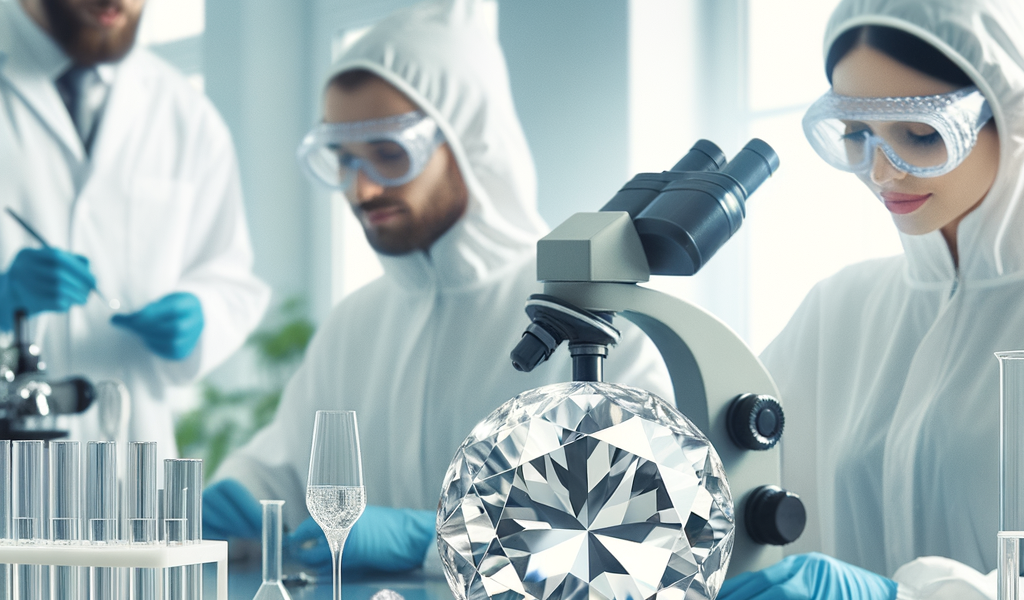Lab-made diamonds, also known as synthetic or cultured diamonds, are created in controlled laboratory environments rather than being mined from the earth. Unlike imitation diamonds, lab-made diamonds have the same chemical composition, crystal structure, and optical properties as mined diamonds.
The concept of lab-made diamonds dates to the mid-20th century when scientists began experimenting with diamond synthesis techniques. Over the years, significant advancements have been made in diamond-growing technologies, leading to the production of high-quality lab-made diamonds.
Comparison with Mined Diamonds
Lab-made diamonds are virtually indistinguishable from mined diamonds in terms of quality and characteristics. They exhibit the same brilliance, sparkle, and durability as natural diamonds. However, there are several key differences between the two:
Quality and Characteristics: Lab-made diamonds are often of superior quality compared to mined diamonds. They are free from impurities and flaws commonly found in natural diamonds, resulting in enhanced clarity and color consistency.
Environmental Impact: Unlike diamond mining, which involves extensive land disruption, habitat destruction, and carbon emissions, the production of lab-made diamonds has minimal environmental impact. It requires significantly less energy and water and produces fewer greenhouse gas emissions.
Cost: Lab-made diamonds typically cost less than mined diamonds of comparable quality. This affordability factor makes them an attractive option for consumers seeking high-quality diamond jewelry at a lower price point.
Sustainability and Ethical Considerations
One of the primary advantages of lab made diamonds is their sustainability. Traditional diamond mining has been associated with various environmental and social issues, including deforestation, water pollution, and human rights abuses. In contrast, lab-made diamonds offer a more environmentally friendly and ethically sound alternative.
The production of lab-made diamonds requires minimal land use and avoids the negative environmental impacts associated with mining. Additionally, lab-made diamonds are conflict-free, eliminating concerns about the sourcing of diamonds from conflict zones.
Technological Advancements
Advancements in diamond synthesis technology have played a significant role in the growth of the lab-made diamond industry. There are two primary methods of creating lab-made diamonds: High Pressure High Temperature (HPHT) and Chemical Vapor Deposition (CVD).
HPHT involves subjecting carbon to high pressure and temperature conditions, simulating the natural diamond formation process. Chemical Vapor Deposition (CVD), on the other hand, utilizes a chemical reaction to deposit carbon atoms onto a substrate, resulting in diamond growth layer by layer.
Market Trends and Consumer Perception
In recent years, there has been a noticeable shift in consumer preference towards lab-made diamonds. This trend can be attributed to several factors, including increased awareness of sustainability issues, changing attitudes towards luxury goods, and advancements in diamond synthesis technology.
The jewelry industry has responded to this demand by offering a wide range of lab-made diamond jewelry options, including engagement rings, earrings, and necklaces. Major retailers and jewelry brands have also started incorporating lab-made diamonds into their collections, further fueling their popularity.
Applications and Uses
Lab-made diamonds have applications beyond the jewelry industry. Due to their exceptional hardness, thermal conductivity, and optical properties, they are used in various industrial applications, including cutting tools, high-performance electronics, and medical devices.
In the jewelry sector, lab-made diamonds offer consumers an ethical and sustainable choice without compromising on quality or beauty. They are an ideal option for eco-conscious individuals who want to make a positive impact with their purchasing decisions.
Addressing Common Myths and Misconceptions
Despite the growing acceptance of lab-made diamonds, there are still some myths and misconceptions surrounding them. One common misconception is that lab-made diamonds are “fake” or of inferior quality compared to mined diamonds. In reality, lab-made diamonds are chemically and optically identical to natural diamonds, making them a legitimate and desirable alternative.
Future Prospects and Growth Potential
The future looks promising for the lab-made diamond industry, with continued advancements in technology and growing consumer acceptance driving market growth. Industry experts predict that the demand for lab-made diamonds will continue to rise as more consumers prioritize sustainability and ethical sourcing in their purchasing decisions.
However, the industry also faces challenges, including market saturation, competition from mined diamonds, and the need for ongoing innovation. Overcoming these challenges will be crucial for sustaining the momentum of the lab-made diamond market and unlocking its full growth potential.
Conclusion
Lab-made diamonds have emerged as a sustainable and ethical alternative to mined diamonds, offering consumers a guilt-free option without compromising on quality or beauty. With advancements in technology, shifting consumer preferences, and increasing awareness of sustainability issues, the future of lab-made diamonds looks bright. As more consumers embrace these lab-grown gems, the industry is poised for continued growth and innovation.
